Ignorance
It’s hard to get to where you want to go if you don’t know where you are.
To get to Pålstorp – Paul’s farmstead – from Mattila, you need to go north. But our instructions said “turn left when you leave Mattila,” so we did.
Those who wrote the instructions had assumed we were staying at Mattila Mäki, a newer cluster of cabins at the top of a hill. We weren’t there. We were at the original Mattila farmstead, and that was on the other side of the road.
So when we followed the directions and turned left at the end of the driveway, we drove further from Petra’s farm instead of toward it.
Another confusion arose from the fact that I have become a city person who thinks the “main” road would be paved. People who live in Finn Forest know that the main road is the gravel way that goes south to north through the forest.
To restate the obvious – it’s nearly impossible to get to where you’re going if you don’t know where you are.
We texted Petra, turned around, and drove back the way we had come.
Once we got back to Mattila, we headed north for Pålstorp.
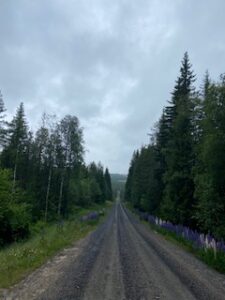
Arriving
Petra had driven her four-wheeler to the end of the cutoff so we couldn’t miss that turn. We waved at one another and then drove as a two-vehicle caravan to her driveway.
We parked by a garage and walked onto the land.
It took my breath. To the left was Petra’s house, maybe 100 years old, so not there when Grandma Lisa left. Straight ahead was a small field and to the right a garden enclosed by a usual Finn Forest slanted pole fence.

When Petra took us to the root cellar just to our left hand, our feet stepped into a path our ancestors has walked for several hundred years.
Jordkelleren the locals call it now – “the earth cellar.” For the Finns it was kivikellari, “the stone cellar.”
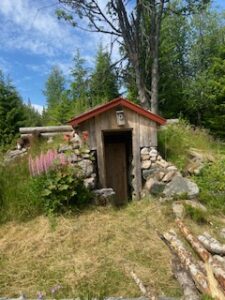
Here Lisa and her mother Marta had stored their food. Through this door everyone in the family had entered.
We joined them when we stepped inside. Through one door frame. Inside that another door.
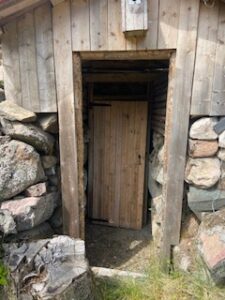
And inside that – a rounded dome of rocks over a stamped dirt floor with straight rock walls.
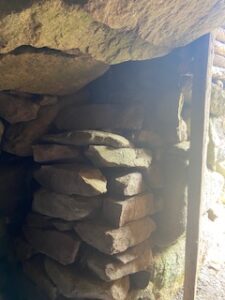
At the top of the back wall, the rocks had been laid so there was a vent for circulation.
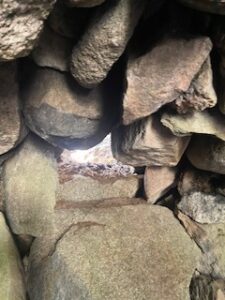
The ceiling was like a cathedral.

We stood in silent awe. They had build this, some of them, far back. Here they had been, in this quiet, useful, nurturing place.
I saw a long object on the floor and picked it up.
“This is where I store things I find around the farm,” Petra said. “I was sure that someday someone would come back.” She looked at the object I held. “What is that?” she asked.
Between Mia and me we explained that it was a horn, like those we’d seen in the Finnskog Center, that the people used to call from farm to farm.
I put it to my lips to blow. My mouth filled with dirt.
“It’s yours,” Petra said. “You can take it.”
I handed the horn to Mia.
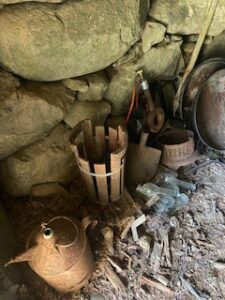
And we walked back into the sunlight.
We looked at the flattened area under a young tree where the house had stood.
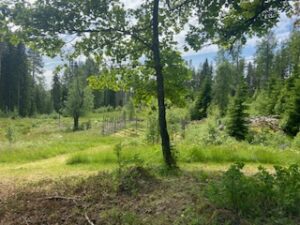
At the four corners, antique flowers remained.
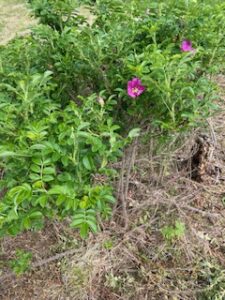
Beyond, in Petra’s garden, stone circles separated the various plots.
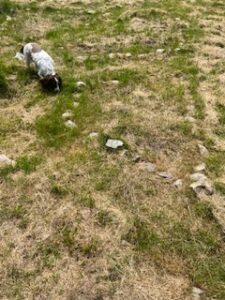
There were words spoken, but beneath them a great silence.
We went back to Karhula and put the horn in front of our stove.
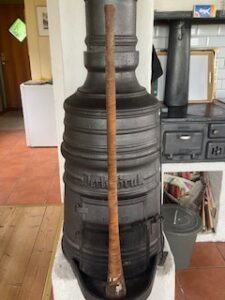
It had been made of birch wood around which inch-wide strips of birch bark had been bound, round after round.
The narrow end would have gone to your lips. From the wider end, a sound would have emerged. To whom did it speak? The goats? The neighbors? The folks working in the fields? What did the sound mean? “Dinner is ready.” “A baby is born.” “Go away, bear.” “Someone is soon to die.” Maybe just: “Morning has come.”
Knowing
Now that we know where we came from, perhaps we’ll know which direction to turn next.

So far we have come – walking down the generations. Yet the great difference here-there says one is more real than the other, more alive, lasting, meaningful, and lost.
I hope not entirely lost, Tom. And now is very real too. (Or perhaps I misunderstand what you’re saying.)